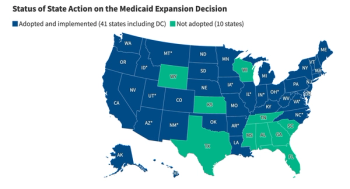
Smaller employers fueling 11% rise in ASO arrangements
Workers covered by ASOs surpassed the number of workers covered by fully insured arrangements in 2009
NATIONAL REPORTS-The number of American workers covered by administrative services only (ASO) agreements surpassed the number of workers covered by commercial fully insured arrangements for the first time in 2009.
Even though enrollment declined slightly in 2010, the trend toward ASOs shows no signs of waning, according to research from Mark Farrah Associates. In the past five years, enrollment in commercial risk products dropped 13% to 86 million, while enrollment in ASO arrangements grew 11% to 91 million.
Healthcare reform already has changed self-funded plans, requiring the coverage of dependents up to age 26, banning coverage limitations for certain services, requiring preventive health services and limiting denials for pre-existing conditions. But self-funded plans are exempt from mandated state benefits, a selling point in areas with large numbers of mandates, says Debra A. Donahue, vice president of market analytics for Mark Farrah Associates.
The overall financial impact of reform on self-funded plans remains unclear because of the freedom such plans have to customize their offerings. For example, many already included preventive health services, so impact on those plans would be less than those that did not have that benefit.
Self-funded options have become more attractive recently because stop-loss insurance providers are increasingly willing to write policies for companies with 50 or fewer employees, says Keith Johnson, executive director at Apex Benefits Services, a national provider of TPA services for health plans.
"In our immediate market in northeast Ohio, companies with 50 employees or so are evaluating self-funding methodology more than in the past," says Johnson. "Most won't go the self-funded route unless they get the amount of stop-loss coverage they want to buy."
A consolidation in the stop-loss industry has resulted in premiums flowing to fewer providers. That allows the surviving companies to better manage the inflow and outflow of catastrophic claims, making them willing to take on smaller clients, Johnson says. That, coupled with improved claims management tools for self-funded plans that contain more stringent cost controls, has made self-funding a viable option for smaller employers.
Johnson compares stop-loss coverage for employers to buying auto insurance. A company willing to take on greater risk can pay less for stop-loss coverage than a company not as willing. The availability of coverage at a price the company is willing to pay often is the deciding factor in whether an employer goes the self-funded route, Johnson says.
Regardless of the availability of more affordable stop-loss premiums, Johnson cautions employers to carefully evaluate the health of their employees and their dependents before considering self-funded options.
"Basically, a company [that chooses self-funding] is betting that its employees are healthier than the population of those insured by commercial products," Johnson says. "If that's the case, then the company is helping to subsidize employer groups with higher risk. The employer doesn't get to retain that surplus unless it pays claims directly."
STOP-LOSS AVAILABLE
Smaller firms can get stop-loss coverage that kicks in after as little as $35,000 in claims to a single insured, which can make self-funding a more viable option.
Even companies that remain in fully insured markets should pay close attention to the trends around ASO. If a company bets that its employees are healthier than the fully insured population and leaves the plan, the remaining workers may be sicker and more at risk as a whole. A sicker population will result in higher rates, which may prompt even more companies to leave the plan, triggering an outflow away from the product much like what occurred with indemnity-style plans a few years ago, according to the Mark Farrah Associates' report.
Any company considering a switch to an ASO model should choose its consultants and vendors carefully. The market has little oversight, but those companies that complete due diligence and make the right decisions could save money over fully insured plans.
"There's a definite trend toward ASO because fully insured premiums are escalating, and employers are saying, 'I can do better than that,'" Donahue says.
Newsletter
Get the latest industry news, event updates, and more from Managed healthcare Executive.






















































